Best studio monitor stands 2024: Optimise your home studio
Everything you need to know about studio monitor stands and why you need them in your recording studio
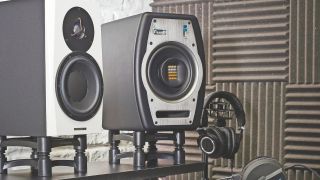
Despite being a relatively small part of your studio setup, a pair of the best studio monitor stands can really help elevate the sound of your mixes. They're not as exciting as purchasing the monitors themselves or some new acoustic panels, but they're just as vital a purchase.
There are a couple of reasons you need a pair of studio monitor stands in your life. First of all, they allow you much more flexibility in your speaker position. Getting your monitors in the sweet spot for listening is key to getting great-sounding mixes. Good monitor stands will allow you to adjust both the height and angle of your speakers, ensuring you're always hearing the mix in full.
The other benefit is the reduction of the phenomenon known as acoustic coupling. Essentially when you place a set of speakers on a desktop, they'll vibrate certain parts of the desk depending on the frequency, masking the actual sound of your mix. Combining a pair of studio monitor stands with some good isolation pads ensures the only sounds you'll hear are those present in your mix.
If you want to know more before you make a decision, then go check out our FAQs section which has loads more info on studio monitor stands. To see the best studio monitor stands available in 2024, keep on scrolling...
Our top picks

Striking the balance beautifully between durability and cost, the On Stage SMS6000-P will suit the vast majority of home studio applications. We particularly love the swappable feet, perfect for uneven floors.

If you're looking for desktop studio monitor stands, we'd go for the IsoAcoustics ISO-155. Combining the best worlds of a studio monitor stand and isolation pad in one, they offer angle adjustment and are relatively low cost for a pair.
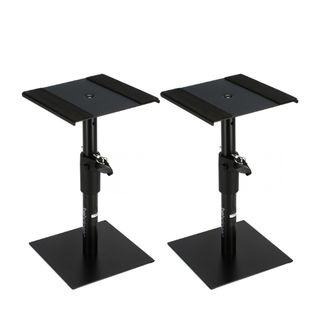
If you've splurged on studio gear then the Behringer SM2001 and will still do a great job of keeping your monitors isolated. You'll need isolation pads to go with them but at less than $50 for a pair, they're perfect for the producer on a budget.
Best overall
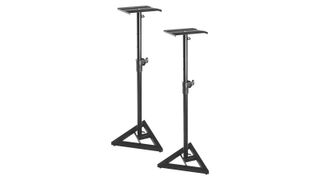
1. On-Stage SMS6000-P studio monitor stands
Our expert review:
Specifications
Reasons to buy
Reasons to avoid
While the brand name itself is a misnomer – these are definitely studio stands, not stage – the On-Stage SMS6000-P make for a superb introduction to dedicated studio monitor stands.
These free-standing stands are constructed from arc-welded steel and, as such, are as tough as they come. With five different height positions, they are ideal for either seated or standing positions and have swappable feet so can be located equally well on carpet or hard floors.
They come with a thin strip of foam which acts as a rudimentary isolator – we’d have preferred something more substantial – but otherwise, these stands are the perfect upgrade for most home recording setups.
Best desktop
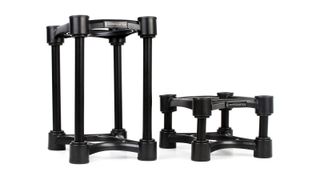
2. IsoAcoustics ISO-155 studio monitor stands
Our expert review:
Specifications
Reasons to buy
Reasons to avoid
If your desk is large enough that you want the speakers to remain there, or if you have an elevated position for your screen already, then a decent on-desk speaker stand solution could be the answer.
The IsoAcoustics ISO-155 are a great example of specialist on-desk stands that provide the isolation and elevation needed to mix and master accurately. As the name suggests, isolation is a key benefit here thanks to the ISO-155’s floating design, ensuring bass frequencies are reproduced accurately and cleanly.
The tilt adjustment means they can be precisely positioned to fit your environment, and they're really easy to put together. The two different lengths of leg mean you can adjust them to your individual setup.
Best budget
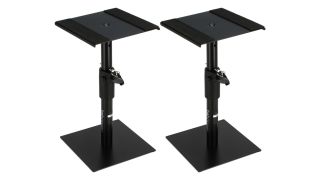
3. Behringer SM2001
Our expert review:
Specifications
Reasons to buy
Reasons to avoid
If you're on a tight budget, then the Behringer SM2001's price point will be music to your ears. You can grab a pair for less than $/£50, making them the best budget studio monitor stands we've come across thus far.
They're super simple to put together, requiring just a single screw to get up and running. Height adjustability means you can make sure your monitors are always in the sweet spot and the top rotates for the perfect angle. The pair we tried were a little loose there, which can be annoying if you accidentally knock them reaching to plug something in or turn on your monitors.
The isolation pads are also pretty thin, so you'll want to upgrade them when you get the chance to something that offers more separation. Small flaws aside, these are absolutely the most affordable studio monitor stands out there at the moment.
Best clamp-on
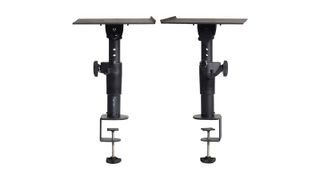
4. Gator Frameworks Clamp-On Studio Monitor Stands
Our expert review:
Specifications
Reasons to buy
Reasons to avoid
For anyone with limited space in their studio, dedicated separate stands aren’t always a viable option. The Gator Clamp-On stands offer a great compromise, by enabling you to attach the stands directly to your desk. This both elevates and isolates the speaker, and also frees up valuable space on the desk itself.
The Gator stands are capable of holding relatively large monitor speakers – up to 60lbs each – and are tilt adjustable up to 15 degrees. All told an excellent solution for smaller studio owners or those who want to make more space for audio interfaces and synthesizers.
The clamps are nice and wide so should fit the vast majority of desktops, or other surfaces you might want to clamp them onto. The EVA-lined surface does offer some isolation, but we'd go one step further and add your own, thicker pads to really ensure they're decoupled from the desk.
Best high-end
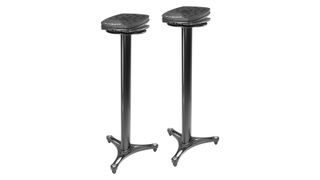
5. Ultimate Support MS-100B studio monitor stands
Our expert review:
Specifications
Reasons to buy
Reasons to avoid
Ideally, in a set of studio monitor stands, you’ll want the perfect blend of sturdiness and isolation. Sturdiness ensures they won’t fall over and drop your prized monitors, and isolation means the sound you hear isn’t being impacted by vibrations.
The Ultimate Support MS-100 set of free-standing studio monitor stands delivers on both fronts. The aluminium construction is rigid and can withstand the odd wobble, while the high-density acoustic foam on which the monitors sit will guarantee nothing is lost sonically as the sound travels from the speaker to your ear.
They feature a sand chamber - which we highly recommend filling - to help you really hear the low end of your mix. We love the cable channels as well that help keep things nice and tidy. They are pricy, but if you want the very best for your studio then this is it.
Best looks
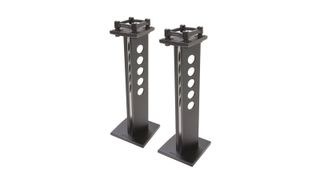
6. Argosy Spire 420i studio monitor stands
Our expert review:
Specifications
Reasons to buy
Reasons to avoid
If you're trying to create a vibe in your studio, then the Argosy Spire 420i studio monitor stands will certainly stand out from the rest. They're not just good-looking either, these are professional-level studio monitor stands with loads of useful features.
The Spire 420i set features the same IsoAcoustic technology we outlined higher up the list, meaning the sound has the best possible isolation from its base, while Argosy claims the angle of the stand legs themselves has been chosen to ‘direct’ sound in the right direction.
Yes, these are more costly than the other options in the list, but the benefits are clear for those who can afford them. The in-stand cable routing is a nice touch too.
FAQs
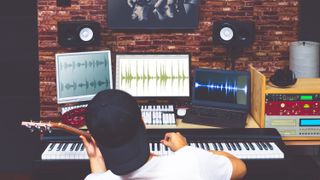
What are studio monitor stands?
Studio monitor stands are, essentially, very simple things. They function, as you’d imagine, by providing an elevated space on which your monitor speakers can stand. Their usefulness, however, far exceeds their simplicity. You see, as well as providing a dedicated space for your monitors to sit, they offer up certain benefits in the way of sound performance, which we’ll outline below. They also have certain practical benefits which, all told, make them one of the more useful purchases you can make to upgrade your recording studio.
What are the types of studio monitor stands?
There are a couple of different forms of studio monitor stands you’ll find. Desktop studio monitor stands reside, as you’d imagine, on your desk and provide an elevated position for the speakers. Dedicated stands, meanwhile, are free-standing and allow you to decouple the speakers from your studio desk. Both types will likely feature – or at least give the option for – some kind of acoustic isolation which acts as a buffer between the stand and the bottom of the speaker. This enhances bass reproduction and lessens the vibrations caused at higher listening volumes.
Regardless of which type you opt for, you’ll want to ensure the speakers stands are sturdy and not likely to wobble. The ability to adjust the height is also important, as you’ll need to locate them at the correct height for your ears. Some stands also allow you to adjust the angle of the speaker, so you can find the perfect balance for your studio and listening position.
What are the benefits of using studio monitor stands?
Using monitor speakers stands should provide an instant benefit to your recording rig. This is because, unlike regular hi-fi speakers which are designed to fill a room with sound, studio monitors are designed for reference. They are engineered in such a way as to provide a tool for critical listening, helping producers balance and mix their sounds. If you can make a sound pleasing on a set of monitors, you can be confident it’ll sound good on any other speaker.
To do this, it’s important – essential, in fact – that the monitors sit level with the ears of whoever is using them. When you’re starting out, a set of shelves (or even a pile of books) can achieve this effect, but for those with an eye on improving their setup, a pair of specialist studio monitor stands make everything more… professional. Shelves, for example, are great for hi-fi speakers but for monitoring they can cause problems with bass frequencies.
This is where isolation comes in – separating the speaker from the floor, desk or shelf improves the sound reproduction massively as you’re not losing bass frequencies in the form of vibration.
There’s also the side benefit of practicality. It stands to reason that, as a producer, you have an ever-growing arsenal of gear. Everything from synths to samplers, and from audio interfaces to effects units. All this gear takes up valuable real estate on your studio desk, so removing the monitor speakers from the equation means you can add more essential gear to your setup.
Will studio monitor stands make me a better producer?
In the same way a more expensive guitar amp won’t necessarily make you a better guitarist, a set of dedicated studio monitor speakers will not in themselves make you better at producing. They will however improve the sound you can hear and give you a better chance of appraising your recordings which, in turn, will improve your ability.
Think about it as giving yourself the best chance of developing as a producer. With your speakers set in the correct position, you’re allowing your sound to breathe and ensuring all those competing frequencies can be properly balanced in the mix.
How we test

Despite being a relatively small part of the home studio setup, studio monitor stands are actually a pretty important aspect of getting good monitoring. To test studio monitor stands we'll perform several checks to ensure they're a good match for you, whether you're just starting a home studio or you have a professional setup.
First of all, we like to know how easy they are to put together. For most desktop studio monitor stands this is typically an easy process, but floor-standing variants can be a lot more difficult to assemble. We're looking for clear instructions and quality components to ensure that this process is easy enough for anyone to handle.
The process of assembling also gives us a good chance to examine the overall build quality. Studio monitors are heavy, so you need a stand that's going to be rugged enough to support it.
We'll also check out the isolation, one of the most important parts of a studio monitor stand's construction. Isolation separates the speaker from the desktop, preventing anything from vibrating in sympathy with the resonances from your speakers.
Testing the actual sound of the monitors on the stands themselves is a much more subjective experience, and for those of us without professional-level recording studios, we can only really compare them to our own stands. This still gives us a good viewpoint into whether or not they offer any improvement.
Find out more about how we test music gear and services at MusicRadar.
Related buyer's guides
MusicRadar's got your back
- Save money with the best budget studio monitors
- Best studio desks: organise your recording studio gear
- The best studio chairs: are you sitting comfortably?
- The best PCs for music production
Get the MusicRadar Newsletter
Want all the hottest music and gear news, reviews, deals, features and more, direct to your inbox? Sign up here.
Chris Corfield is a journalist with over 12 years of experience writing for some of the music world's biggest brands including Orange Amplification, MusicRadar, Guitar World, Total Guitar and Dawsons Music. Chris loves getting nerdy about everything from guitar and bass gear, to synths, microphones, DJ gear and music production hardware.
- Matt McCrackenJunior Deals Writer
Most Popular








